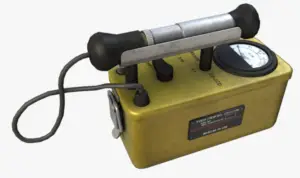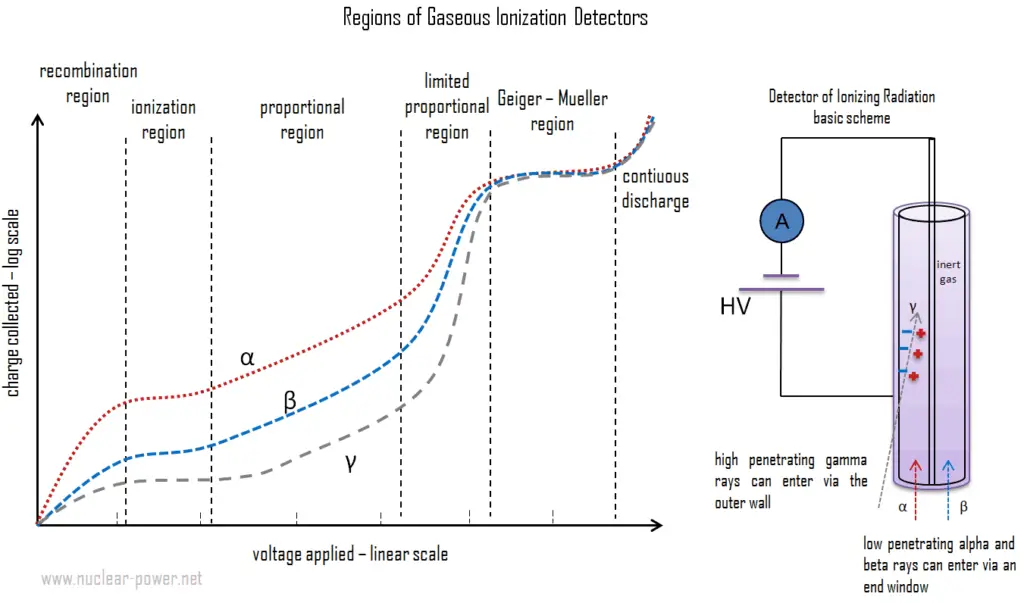
Gaseous ionization detectors are widely used in nuclear power plants, for the most part, to measure alpha and beta particles, neutrons, and gamma rays. The detectors operate in the ionization, proportional, and Geiger-Mueller regions with an arrangement most sensitive to the type of radiation being measured. Neutron detectors utilize ionization chambers or proportional counters of appropriate design. Compensated ion chambers, BF3 counters, fission counters, and proton recoil counters are examples of neutron detectors.
Advantages and Disadvantages depending on Detector Voltage
The relationship between the applied voltage and pulse height in a detector is very complex. Pulse height and the number of ion pairs collected are directly related. As was written, the voltages can vary widely depending upon the detector geometry and the gas type and pressure. The figure schematically indicates the different voltage regions for alpha, beta and gamma rays. There are six main practical operating regions, where three (ionization, proportional and Geiger-Mueller region) are useful to detect ionizing radiation. These reqions are shown below. The alpha curve is higher than the beta and gamma curve from recombination region to part of limited proportionality region due to the larger number of ion pairs produced by the initial reaction of the incident radiation.

- Recombination Region. At low voltage, the electric field is not large enough to accelerate electrons and ions. The electrons and ions can recombine soon after they are produced, and only a small fraction of the produced electrons and ions reach their respective electrodes. As the detector voltage is increased, however, an increasingly large fraction of the ions produced will reach the electrodes. This increase continues until the “saturation” voltage is attained. The range of operating voltage where this occurs is referred to as the recombination region. Detectors are not operated in this region, because neither the number of recombinations nor the number of ion-pairs initially produced can be determined accurately.
- Ionization Region. In the ionization region, an increase in voltage does not cause a substantial increase in the number of ion-pairs collected. The number of ion-pairs collected by the electrodes is equal to the number of ion-pairs produced by the incident radiation, and is dependent on the type and energy of the particles or rays in the incident radiation. Therefore, in this region the curve is flat. The voltage must be higher than the point where dissociated ion-pairs can recombine. On the other hand, the voltage is not high enough to produce gas amplification (secondary ionization). Detectors in the ionization region operate at a low electric field strength, selected such that no gas multiplication takes place. Their current is independent of the applied voltage, and they are preferred for high radiation dose rates because they have no “dead time”, a phenomenon which affects the accuracy of the Geiger-Mueller tube at high dose rates.
- Proportional Region. In the proportional region, the charge collected increases with a further increase in the detector voltage, while the number of primary ion-pairs remains unchanged. Increasing the voltage, provides the primary electrons with sufficient acceleration and energy so that they can ionize additional atoms of the medium. These secondary ions formed are also accelerated causing an effect known as Townsend avalanches, which creates a single large electrical pulse. Even though there is a large number of secondary ions (about 103 – 105) for each primary event, the chamber is always operated such that the number of secondary ions is proportional to the number of primary events. It is very important, because the primary ionization is dependent on the type and energy of the particles or rays in the intercepted radiation field. The number of ion pairs collected divided by the number of ion pairs produced by the primary ionization provides the gas amplification factor (denoted by A). The gas amplification that occurs in this region can increase the total amount of ionization to a measurable value. The process of charge amplification greatly improves the signal-to-noise ratio of the detector and reduces the subsequent electronic amplification required. When instruments are operated in the proportional region, the voltage must be kept constant. If a voltage remains constant the gas amplification factor also does not change. Proportional counter detection instruments are very sensitive to low levels of radiation. Moreover, proportional counters are capable of particle identification and energy measurement (spectroscopy). Different energies of radiation and different types of radiation can be distinguished by analyzing the pulse height, since they significantly differ in the primary ionization.
- Limited Proportional Region. In the limited proportional region, the gas amplification factor does not continue to increase proportionally to the voltage. Additional ionizations and nonlinear effects causes, that there is no proportionality of the output signal to the deposited energy at a given applied voltage. The electric field in the chamber is distorted due to the high positive ion concentration. Free electrons are much lighter than the positive ions, thus, they are drawn toward the positive central electrode much faster than the positive ions are drawn to the chamber wall. The resulting cloud of positive ions near the electrode leads to distortions in gas multiplication. This region is usually avoided as a detection region.
- Geiger-Mueller Region. In the Geiger-Mueller region, the voltage and thus the electric field is so strong that secondary avalanches can occur. These avalanches can be triggered and propagated by photons emitted by atoms excited in the original avalanche. Since these photons are not affected by the electric field, they may interact far (e.g. laterally to the axis) from the primary avalanche, the entire Geiger tube is participating in the process. A strong signal (the amplification factor can reach about 1010) is produced by these avalanches with shape and height independently of the primary ionization and the energy of the detected photon. Detectors, which are operated in the Geiger-Mueller region, are capable of detection of gamma rays, and also of all types of charged particles, that can enter the detector. These detectors are known as Geiger counters. Main advantage of these instruments is that they usually do not require any signal amplifiers. Since the positive ions do not move far from the avalanche region, a positively charged ion cloud disturbs the electric field and terminates the avalanche process. In practice the termination of the avalanche is improved by the use of “quenching” techniques. In contrast to proportional counters the energy or even incident radiation particle cannot not be distinguished by Geiger counters, since the output signal is independent of the amount and type of original ionization.
- Discharge Region. Finally, at still higher voltages (above Geiger-Mueller region), the electric field generates a continuous discharge of the medium, with the chamber no longer being sensitive to any incident ionization. This region is not used for detection or measurement of ionizing radiation. If the Geiger tube voltage is increased above the end of the plateau the count rate begins to increase rapidly again, until the onset of continuous discharge where the tube cannot detect radiation, and may be damaged.
We hope, this article, Advantage and Disadvantage of Gaseous Ionization Detectors, helps you. If so, give us a like in the sidebar. Main purpose of this website is to help the public to learn some interesting and important information about radiation and dosimeters.